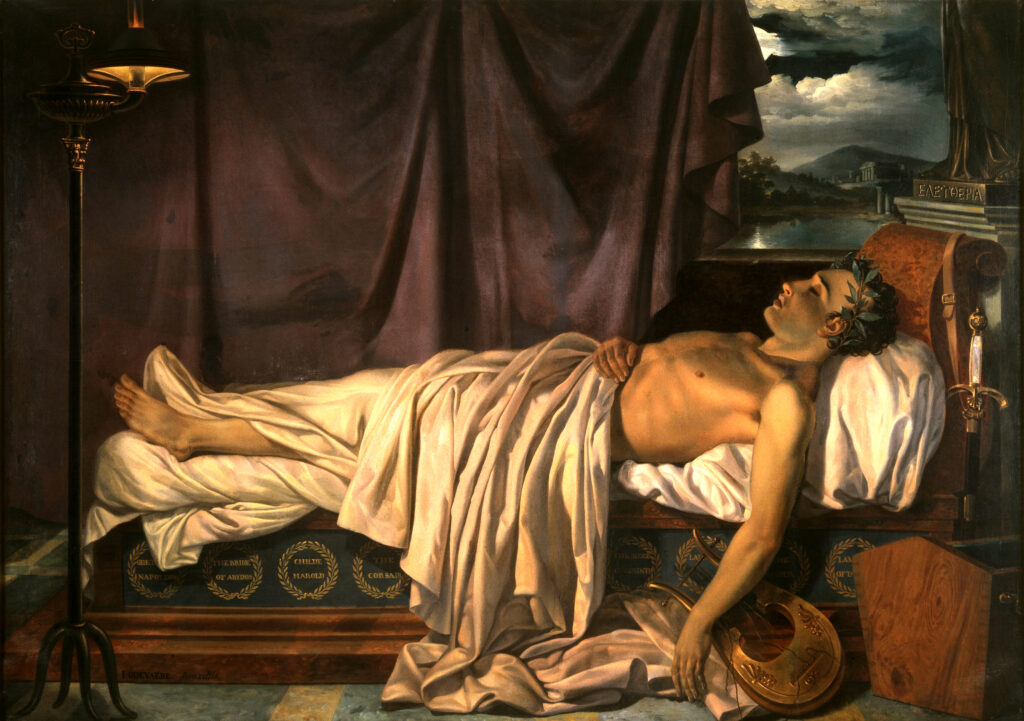Lord Byron Was ‘Mad, Bad, and Dangerous To Know’ — and Now He Can Be Found at the New York Public Library
The Romantic poet and hero of Greek independence was sublime on the page and a scandal off it.

Lady Caroline Lamb called her lover, the poet George Gordon — the Sixth Baron Byron — “mad, bad, and dangerous to know.” Now the aristocrat of centuries past is the center of an exhibit, “Byron: A Life in Motion,” at the New York Public Library. It draws on a store of treasures relating to the Romantics. Byron was a celebrity avant la lettre, a sensation and a scandal. A poet and a peer, he is in the firmament of English literature.
“A Life in Motion” gathers letters to and from Byron, manuscripts, books, paintings, prints, and even wine bills. Those who have long enjoyed his masterpieces — “Don Juan,” “Childe Harold’s Pilgrimage,” and his shorter lyrics — now can press their faces to the glass behind which lie pages of his spidery scrawl. Byron was in the van of those poets who came to be known as “Romantics,” and his life had something of the turbulence of a fairy tale.
The future Lord Byron was born in 1788 to a family that could list its lineage back to a comrade-in-arms of William the Conqueror. His grandfather set a speed record for circumnavigating the globe. At the age of 10 he inherited the family seat of Newstead Abbey, in Nottinghamshire. He spent three years at Trinity College, Cambridge, where a clubbed right foot did not prevent him from excelling as a sportsman, with a special aptitude for swimming.
Byron’s verse catapulted him to fame at a young age. He reflected: “I awoke one morning and found myself famous.” One biographer reckons that he was “the most brilliant star in the dazzling world of Regency London. He was sought after at every society venue, elected to several exclusive clubs, and frequented the most fashionable London drawing-rooms.” His friendship with a Jewish conductor, Isaac Nathan, led to Byron’s “Hebrew Melodies.”

Via Wikimedia Commons
The beauty of Byron’s writing was matched only by the chaos of his living. He was dogged by a rumored affair with his half-sister, Augusta Leigh. His marriage to Annabella Millbanke was a disaster, and his debts ruinous. The aristocrat embarked on dangerous affairs with both men and women, and the concentric controversies impelled him to leave England in 1816. He would return eight years later — but as one of the most celebrated corpses of the Empire.
“A Life in Motion” attends to Byron’s mess as well as his Muse. The show reports that he “loved seltzer water, fish sauce, horseback riding, pistols, sex, swimming, and fancy clothes.” He was part of the coterie that, over three waterlogged days in Switzerland, handed up Mary Shelley’s “Frankenstein” and John William Polidori’s “The Vampyre.” Byron attended the beachside cremation of Percy Bysshe Shelley after his drowning in the Bay of Lerici.
Byron’s final chapter was his most memorable. He became consumed by the Greek War of Independence and the effort to cleave an independent Greece from Ottoman rule. He commissioned a brig called, naturally, Hercules, to take him to the land of Hercules and Achilles. The poet, though, never saw battle. He died of fever — and relentless bloodletting, that era’s standard of care — at Missolonghi, on the west coast of Greece. He was 36.
Byron is regarded as a Homeric hero in Greece. Had he lived he might have been king. “A Life in Motion” explains in a wall label that “Byron’s death … was news across the world. Writers of the next generation, not yet Victorians — Tennyson, Swinburne, Carlyle, Mathew Arnold — were heart-stricken.” English high society, though, sent only empty carriages to his funeral to pay their respects. Even in death, he was dangerous to know.

